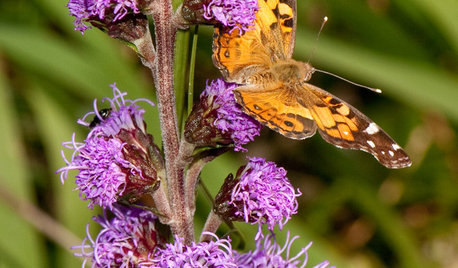American Lady
MissSherry
10 years ago
Related Stories

GARDENING GUIDESAmerican Lady Butterflies Add Delight to Summer Gardens
Provide native nectar and larval host plants to welcome these migratory butterflies
Full Story
CRAFTSMAN DESIGNAmerican Architecture: The Elements of Craftsman Style
Proud of its handiwork details and with nature as inspiration, Craftsman architecture stands out for its purity of style
Full Story
DECORATING GUIDESCelebrating the Great American Quilt
They speak of family, history and beauty. Is it any wonder quilts transcend design styles?
Full Story
HOUZZ TVHouzz TV: A Famed ‘Painted Lady’ Gets a Gorgeous Update
Join us as we walk with the homeowners through one of San Francisco's landmark Victorians, lovingly restored
Full Story
LIFEA Month-by-Month Guide to ‘Downton Abbey’ Withdrawal
Missing Lady Grantham’s zingers? Edith’s furrowed brow? Romance simmering downstairs? Here’s help to get you through until season 6
Full Story
GARDENING FOR BIRDSWild Birds Transform a Woman’s Garden and Life
How Sharon Sorenson created a wildlife haven and became the Bird Lady of Southern Indiana
Full Story
HOUZZ TOURSHouzz Tour: Step Inside (and Out) a New Florida Showhouse
2012 'New American Home' at International Builders Show celebrates latest materials and ideas for luxurious, indoor-outdoor living
Full Story
ARCHITECTURERoots of Style: See What Defines a Craftsman Home
Charming features and intimate proportions have made Craftsman houses an American favorite. See their common details and variations
Full Story
SHOP HOUZZShop Houzz: An Ode to Frank Lloyd Wright
Quite frankly, it doesn’t get much better than this iconic American designer and architect
Full Story







Leafhead
runmede
Related Professionals
Boca Raton Landscape Contractors · Melrose Landscape Contractors · Shaker Heights Landscape Contractors · Wilton Landscape Contractors · Bonney Lake Fence Contractors · Goose Creek Fence Contractors · Lorton Fence Contractors · Naperville Fence Contractors · Piedmont Fence Contractors · Bay Village Window Contractors · Crestwood Window Contractors · Granite City Window Contractors · Kuna Window Contractors · Payson Window Contractors · White Center Window Contractorslinda_tx8
MissSherryOriginal Author
runmede
MissSherryOriginal Author
Liz
Leafhead